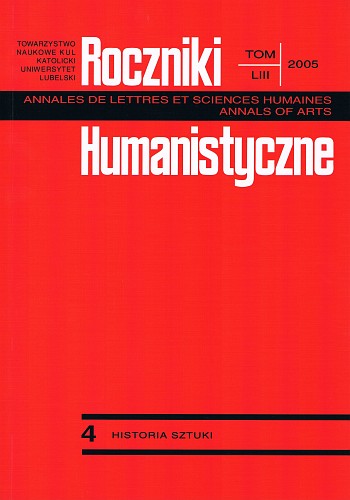Gotycka polichromia Domu Długosza w Wiślicy
Gothic Polychrome on the Długosz Home in Wiślica
Author(s): Edyta KlingerSubject(s): Fine Arts / Performing Arts, Architecture
Published by: Towarzystwo Naukowe KUL & Katolicki Uniwersytet Lubelski Jana Pawła II
Keywords: painting; polychrome; Wiślica; Długosz
Summary/Abstract: In 1960, during architectural study conducted in the Długosz Home in Wiślica fragments of Gothic polychrome were discovered. The whole of it was uncovered in 1999-2004. On the basis of analysis of stratigraphy of layers of particular sections of the walls it was determined that the polychrome was painted at the same time as the building, that is after 1460.The frescos were founded by Jan Długosz. This is proven by a similarity of the picture of the founder from the Wiślica fresco and his portrait on the plaque in Dom Psałterzystów(Psalterists’ Home), also founded by him, and by the co at of arms Wieniawa placed on the ceiling of a room in Wiślica. The Wiślica polychrome is probably a work by a Małopolska workshop or master; however, comparing its style to wall polychromes in the Małopolska area does not allow ascribing the painting to one of their authors. On the basis of the style it should be dated to the years between 1460’s and early 1480’s, when in wall painting the tendency can be seen to build the form with a strong contour and a great role is still played by flat color patches.The greatest part of the polychrome is placed on the south wall. The composition consists of two scenes between which, over the entrance, the Martyred Christ is depicted. On his right two people are shown who are turned towards Christ: a kneeling canon with his hands in the gesture of prayer, and a saint with a crucifix in her hand, who is standing behind the canon. Over the man there is a ribbon with the Latin inscription m[iser]ere mei deus nostrum. The scene on the left presents five people: three soldiers, a man and a woman standing on a platform (a balcony or a tribune) that is suggested by a hanging cloth.Christ is p re sented in the iconographie type that is usually defin ed as Imago Pietatis, Misericordia Domini, Christ in the Well, and recently - Martyred Christ. The saint standing behind Długosz and holding a crucifix in her hand might be an image of St Helen whose cult was spread owing to Crusades and to the relics of the Wood of the Holy Cross famous for the graces. However, it may also be St Kinga whose life Długosz described. The representation on the right side of Christ is of a different character from the one on the opposite side; it is ‘‘taken ou t” of history. The closest analogies may be seen in the scenes of Christ Before Pilate, and Flagellation. The figures on the Wiślica fresco that have the form of portraits can be identified with the persons of Pilate and his wife Procula. What is unusual is the attitude the figures shown here - in a defined time and space - take towards the image of the Martyred Christ, who (by the act of incorporation and redemption completed in time) is above time.The composition of the south wall does not have analogy. The arrangement of the scenes shown here, their contents, scale and their painting stylistics make one recognize this part of the polychrome as the most important in the whole program: the Martyred Christ is standing in the sepulcher - the sign of Resurrection, victory over death. He carries signs of his Passion, in which he offered himself as a sacrifice for man - for the love of him. His gesture - one of presentation - is a gesture of presentation of love, of his devotion to man. And presentation assumes existence of the recipient, it requires his existence. An actual man, Jan Długosz, a canon, Christ’s disciple, found a recipient in himself. He is adoring Christ, pays homage to him, and completely gives him self up to him. The saint standing behind Długosz does not only play the role of one who intercedes for him; she is saint through he r faith in the cross. Together with Długosz she intercedes for the whole Church that received a promise to be redeemed exactly through the cross.Redemption was completed in history - in an actual time and place. The scene on the right refers just to history. It is by Pilate ’s consent that Jesus is sentenced, despite his wife P ro c u la ’s warnings. He is sentenced to his Passion, to which the rod and whip refer; they are shown on C h rist’s both sides, at the same time joining the two scenes into one whole; two realities into one message. On the borderline between them a soldier orders silence that is silence in the face of the Mystery of Redemption. Like Długosz, when he prays, man touches the sacred; the mystery ordering silence - completed and being completed (in the sacrament). The scene “ taken out of history” is a proof of completion of the Mystery.
Journal: Roczniki Humanistyczne
- Issue Year: 53/2005
- Issue No: 04
- Page Range: 67-96
- Page Count: 30
- Language: Polish

